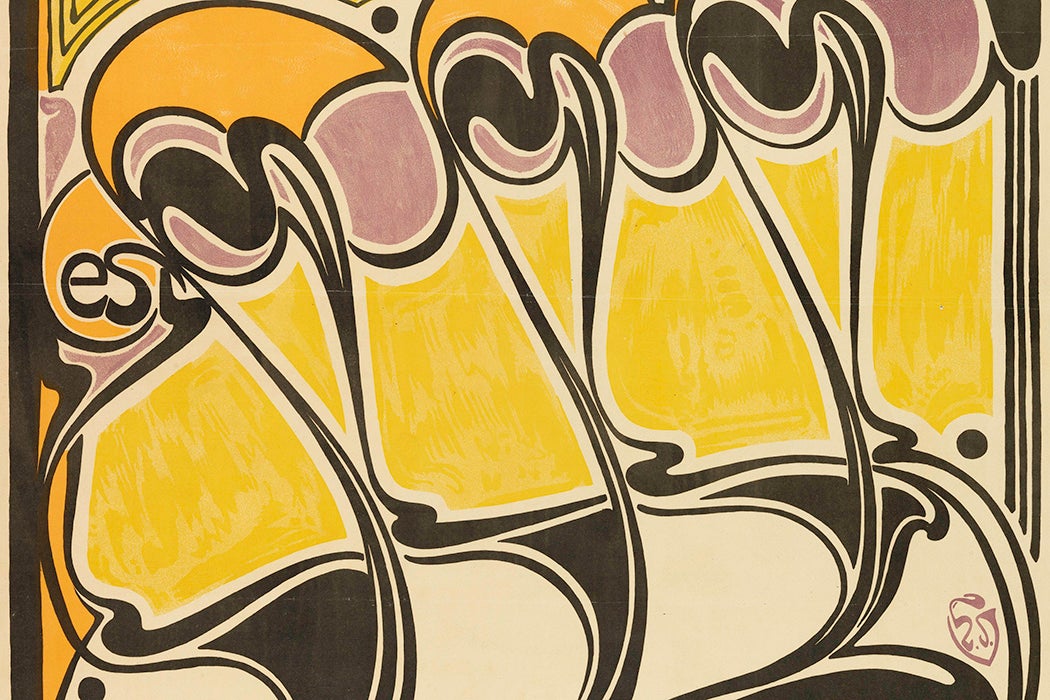Art Nouveau remains one of the most popular forms of modern art. The style had multiple permutations and names in different countries in fin-de-siècle Europe, but it was first named “art nouveau” in Belgium in the 1880s. There, “pioneers in modern design” including Victor Horta, Henry van de Velde, Paul Hankar, and Philippe Wolfers created the curvy new style as the country exploded in development on the profits from King Leopold II’s murderous Congo Free State.
Scholar Debora L. Silverman argues that this context was no coincidence. Belgian Art Nouveau was an “imperial modernism,” with “profound and inextricable ties, long unexamined, between the Belgian arts and artists […] and the patrons, policies, violence, and even the expressive forms of Congo imperialism.”
“These artists’ creative consciousnesses were also vitalized by the sudden and successful Congo venture,” she notes, “and they shared the exhilaration of their contemporaries, as well as some of the collective derangement, over the fact that their small, new, and neutral nation has ‘acquired’ one-thirteenth of the African continent.”
Artists used raw materials from the colony, including ivory and tropical hardwoods. They were inspired by colonial motifs, including the “sinuous coils” of the rubber vine and the lash of the chicotte, or imperial flogging whip made of hippopotamus hide. (An early Belgium name for the new art was Style coup de fouet, or whiplash style.) And they were supported by patrons, above all Leopold II, who—engorged with profits from the colony, especially from rubber—commissioned their buildings and bought their works.
The colonial history here is unique. In 1885, as the European powers divided up Africa, Leopold II managed to gain control of the Congo region. The resulting L’État indépendant du Congo wasn’t technically a colony of what was then a half-century-old Belgian state. It was Leopold II’s personal colony. His minions proceeded to extract rubber, palm oil, ivory, and exotic hardwoods out a place much larger than Belgium itself. Shareholders in his exploitation of the Congo earned an average stock dividend of 220% from the plundering between 1892 and 1897.
“By 1905,” writes Silverman, “two decades of contact with the Congo Free State had remade Belgium as a global hub, vitalized by a tentacular economy, technological prowess, and architectural grandiosity.”
Buoyed by the wealth of what critics called bloody “red rubber,” the “Builder King” himself never visited his African fiefdom. By the time the state of Belgium annexed the Congo from Leopold II in 1908 in response to the world-wide scandal over conditions there, his regime “of forced labor, invasion terror, hostage taking, and hand severing” had murdered millions of Congolese. (Silverman cites a figure of four to eight million; Adam Hochschid’s King Leopold’s Ghost, which introduced the historical record to many in 1998, argues for a higher figure: ten million lives.)
Silverman focuses on the 2005 exhibition La mémoire du Congo, le temps colonial, at the Royal Museum for Central Africa (now known as AfricaMuseum) in Tervuren, Belgium. The exhibition “attempted to confront for the very first time the brutal history of Belgium in the Congo.” This history was “long suppressed in what had become the pivotal institution of official national denial and the most visible and provocative embodiment of the ‘great forgetting’” of Belgium’s role in Africa—a role that lasted long after Leopold II’s death in 1909. (In 2002, Belgium formally apologized for its role in the 1961 assassination of the Democratic Republic of the Congo’s first Prime Minister, Patrice Lumumba, whose body was hacked up and dissolved in acid after death.)
Weekly Newsletter
Calling the exhibit “flawed and evasive,” Silverman nevertheless argues that the display of long-unseen objects, especially works in ivory, helped to reveal the “art of darkness” behind Belgian Art Nouveau. The phrase intentionally echo’s Joseph Conrad’s famous 1899 novella Heart of Darkness, which explores European imperialism in the Congo.
Silverman ends with the words of Henry Van de Velde, who explained the “eruption of modern line” in the “breakthrough” of Art Nouveau, transposing Belgian violence in the Congo into the new art in Belgium: “We seized line like one seizes a whip. A whip whose sonorous cracks accompanied our adventurous course, and whose blows lashed the skin of an indolent public.”
Support JSTOR Daily! Join our new membership program on Patreon today.







